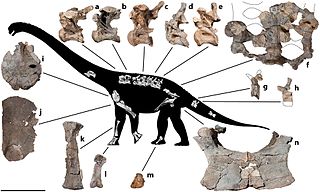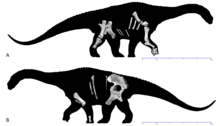
Titanosaurs were a diverse group of sauropod dinosaurs, including genera from all seven continents. The titanosaurs were the last surviving group of long-necked sauropods, with taxa still thriving at the time of the extinction event at the end of the Cretaceous. This group includes some of the largest land animals known to have ever existed, such as Patagotitan—estimated at 37 m (121 ft) long with a weight of 69 tonnes —and the comparably-sized Argentinosaurus and Puertasaurus from the same region.

Nemegtosauridae is a family of titanosaurian sauropod dinosaurs based on their diplodocid-like skulls. Only three species are known: Nemegtosaurus, Quaesitosaurus and possibly Tapuiasaurus, each from the Cretaceous.

Alamosaurus is a genus of opisthocoelicaudiine titanosaurian sauropod dinosaurs containing a single known species, Alamosaurus sanjuanensis, from the Maastrichtian age of the Late Cretaceous period in what is now southwestern North America. Isolated vertebrae and limb bones indicate that it reached sizes comparable to Argentinosaurus and Puertasaurus, which would make it the absolute largest dinosaur known from North America. Its fossils have been recovered from a variety of rock formations spanning the Maastrichtian age. Specimens of a juvenile Alamosaurus sanjuanensis have been recovered from only a few meters below the Cretaceous-Paleogene boundary in Texas, making it among the last surviving non-avian dinosaur species. Alamosaurus is the only known sauropod to have inhabited North America after their nearly 30-million year absence from the North American fossil record and probably represents an immigrant from South America.

Opisthocoelicaudia is a genus of sauropod dinosaur of the Late Cretaceous Period discovered in the Gobi Desert of Mongolia. The type species is Opisthocoelicaudia skarzynskii. A well-preserved skeleton lacking only the head and neck was unearthed in 1965 by Polish and Mongolian scientists, making Opisthocoelicaudia one of the best known sauropods from the Late Cretaceous. Tooth marks on this skeleton indicate that large carnivorous dinosaurs had fed on the carcass and possibly had carried away the now-missing parts. To date, only two additional, much less complete specimens are known, including part of a shoulder and a fragmentary tail. A relatively small sauropod, Opisthocoelicaudia measured about 11.4–13 m (37–43 ft) in length. Like other sauropods, it would have been characterised by a small head sitting on a very long neck and a barrel shaped trunk carried by four column-like legs. The name Opisthocoelicaudia means "posterior cavity tail", alluding to the unusual, opisthocoel condition of the anterior tail vertebrae that were concave on their posterior sides. This and other skeletal features lead researchers to propose that Opisthocoelicaudia was able to rear on its hindlegs.

Andesaurus is a genus of basal titanosaurian sauropod dinosaur which existed during the middle of the Cretaceous Period in South America. Like most sauropods, belonging to one of the largest animals ever to walk the Earth, it would have had a small head on the end of a long neck and an equally long tail.
Venenosaurus is a genus of sauropod dinosaur that lived in what is now Utah during the Early Cretaceous. Its type and only species is Venenosaurus dicrocei. Fossils of Venenosaurus were first discovered in 1998, by Denver Museum of Natural History volunteer Anthony DiCroce, and described as a new genus and species in 2001 by Virginia Tidwell and colleagues, who named the species for DiCroce. Venenosaurus was a relatively small sauropod, and was similar to Cedarosaurus, another sauropod from the Early Cretaceous of Utah.

Tendaguria is a genus of herbivorous sauropod dinosaur from the Late Jurassic of Lindi Region, Tanzania.

Neuquensaurus is a genus of saltasaurid sauropod dinosaur that lived in the Late Cretaceous, about 80 million years ago in Argentina in South America. Its fossils were recovered from outcrops of the Anacleto Formation around Cinco Saltos, near the Neuquén river from which its name is derived.

Lirainosaurus is a genus of titanosaur sauropod which lived in what is now Spain. The type species, Lirainosaurus astibiae, was described by Sanz, Powell, Le Loeuff, Martinez, and Pereda-Suberbiola in 1999. It was a relatively small sauropod, measuring 4 metres (13 ft) long, possibly up to 6 metres (20 ft) long for the largest individuals, and weighed about 2–4 metric tons.

Saltasauridae is a family of armored herbivorous sauropods from the Upper Cretaceous. They are known from fossils found in South America, Africa, Asia, North America, and Europe. They are characterized by their vertebrae and feet, which are similar to those of Saltasaurus, the first of the group to be discovered and the source of the name. The last and largest of the group and only one found in North America, Alamosaurus, was thirty-four metres in length and one of the last sauropods to go extinct.

Lithostrotia is a clade of derived titanosaur sauropods that lived during the Early Cretaceous and Late Cretaceous. The group was defined by Upchurch et al. in 2004 as the most recent common ancestor of Malawisaurus and Saltasaurus and all the descendants of that ancestor. Lithostrotia is derived from the Ancient Greek lithostros, meaning "inlaid with stones", referring to the fact that many known lithostrotians are preserved with osteoderms. However, osteoderms are not a distinguishing feature of the group, as the two noted by Unchurch et al. include caudal vertebrae with strongly concave front faces (procoely), although the farthest vertebrae are not procoelous.

Australovenator is a genus of megaraptoran theropod dinosaur from Cenomanian -age Winton Formation of Australia. It is known from partial cranial and postcranial remains which were described in 2009 by Scott Hocknull and colleagues, although additional descriptions and analyses continue to be published. It is the most complete predatory dinosaur discovered in Australia. It has been suggested that Australovenator is a sister taxon to Fukuiraptor, although some phylogenetic analyses find it to be a more derived member of the Megaraptora, possibly being part of the main Megaraptoridae family itself.

Wintonotitan is a genus of titanosauriform dinosaur from Cenomanian -age Winton Formation of Australia. It is known from partial postcranial remains.

Australian Age of Dinosaurs Ltd. (AAOD) is a nonprofit organization located in Winton, Queensland, founded by David Elliott and Judy Elliott in 2002. The organization’s activities include the operation of the Australian Age of Dinosaurs Museum of Natural History, which holds annual dinosaur digs in the Winton Formation of Western Queensland and oversees the year-round operation of Australia's most productive dinosaur fossil preparation laboratory. Since 2005, the AAOD Museum has accumulated the largest collection of Australian dinosaur fossils in the world and holds the holotype specimens of Diamantinasaurus matildae ("Matilda"), Savannasaurus elliottorum ("Wade"), Australovenator wintonensis ("Banjo"), Australia's most complete theropod skeleton, Ferrodraco lentoni, the first pterosaur to be named from the Winton Formation, and Confractosuchus sauroktonos. The museum is open to the public daily from April to October and is open six days a week from November to March. The site of the museum was designated a dark-sky preserve, the first International Dark-Sky Sanctuary in Australia, in 2019.

Patagotitan is a genus of titanosaurian sauropod dinosaur from the Cerro Barcino Formation in Chubut Province, Patagonia, Argentina. The genus contains a single species known from at least six young adult individuals, Patagotitan mayorum, which was first announced in 2014 and then named in 2017 by José Carballido and colleagues. Preliminary studies and press releases suggested that Patagotitan was the largest known titanosaur and land animal overall, with an estimated length of 37 m (121 ft) and an estimated weight of 69 tonnes. Later research revised the length estimate down to 31 m (102 ft) and weight estimates down to approximately 50–57 tonnes, suggesting that Patagotitan was of a similar size to, if not smaller than, its closest relatives Argentinosaurus and Puertasaurus. Still, Patagotitan is one of the most-known titanosaurs, and so its interrelationships with other titanosaurs have been relatively consistent in phylogenetic analyses. This led to its use in a re-definition of the group Colossosauria by Carballido and colleagues in 2022.

Sarmientosaurus is a genus of titanosaurian sauropod dinosaur belonging to the Titanosauria. It lived in what is now South America, specifically Argentina, during the Upper Cretaceous Period about 95 million years ago. The type species is Sarmientosaurus musacchioi.

Savannasaurus is a genus of titanosaurian sauropod dinosaur from the Late Cretaceous Winton Formation of Queensland, Australia. It contains one species, Savannasaurus elliottorum, named in 2016 by Stephen Poropat and colleagues. The holotype and only known specimen, originally nicknamed "Wade", is the most complete specimen of an Australian sauropod, and is held at the Australian Age of Dinosaurs museum. Dinosaurs known from contemporary rocks include its close relative Diamantinasaurus and the theropod Australovenator; associated teeth suggest that Australovenator may have fed on the holotype specimen.

Colossosauria is a clade of titanosaur sauropods from the latest Early Cretaceous through the Late Cretaceous of South America. The group was originally named by Bernardo González-Riga et al. in 2019 and defined as the "most inclusive clade containing Mendozasaurus neguyelap but not Saltasaurus loricatus or Epachthosaurus sciuttoi". The clade contains different taxa depending on the phylogenetic analysis used, in the defining paper the only subgroups were Rinconsauria and Lognkosauria, but alternate phylogenies published previously had also included various similar titanosaurs such as Aeolosaurus, Bonitasaura, Drusilasaura, Overosaurus and Quetecsaurus. The phylogenetic analysis of González-Riga et al. (2019) placed Colossosauria as sister taxa to Epachthosaurus, Pitekunsaurus and a larger clade including Saltasauridae.

Diamantinasauria is an extinct clade of somphospondylan titanosauriform sauropod dinosaurs with close affinities to the Titanosauria, known from the early Late Cretaceous (Cenomanian-Turonian) of South America and Australia. It was named by Poropat and colleagues in 2021, and contains four genera: Australotitan, Savannasaurus and Diamantinasaurus from the Winton Formation of Queensland, as well as Sarmientosaurus from the Bajo Barreal Formation of Patagonia. The existence of the clade indicates connectivity between Australia and South America via Antarctica during the Cretaceous period.

Australotitan is an extinct genus of possibly titanosaurian somphospondylan dinosaurs from the Late Cretaceous Winton Formation (Cenomanian–Turonian) of southern-central Queensland, Australia. The genus contains a single species, A. cooperensis, known from multiple partial skeletons. The genus Australotitan may be synonymous with Diamantinasaurus, a contemporary relative.






































